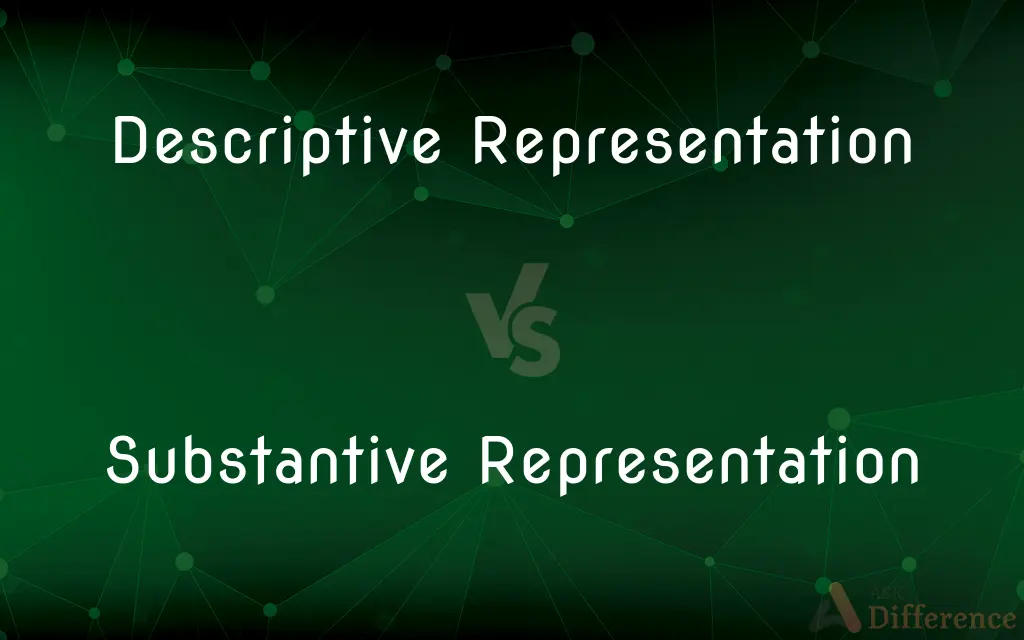Descriptive Representation vs. Substantive Representation — What's the Difference?
Edited by Tayyaba Rehman — By Fiza Rafique — Published on December 27, 2023
Descriptive Representation refers to officials mirroring the demographic characteristics of their constituents. Substantive Representation means officials advocate for the interests and policies desired by their constituents.

Difference Between Descriptive Representation and Substantive Representation
Table of Contents
ADVERTISEMENT
Key Differences
Descriptive Representation emphasizes the importance of representatives looking like the community they serve. This perspective contends that if a representative shares the same demographic traits (like gender, race, or ethnicity) as their constituents, they are more likely to understand and empathize with their unique challenges. On the other hand, Substantive Representation focuses on the actions and policy advocacies of representatives.
Substantive Representation argues that the effectiveness of a representative isn't determined by their demographic alignment with their constituents but by their dedication to pushing for policies and initiatives that their constituents desire. Conversely, Descriptive Representation highlights that shared demographic characteristics can enhance the legitimacy of a representative, making their constituents feel more genuinely represented.
Descriptive Representation can be seen as a response to historical imbalances in political representation. Proponents argue that ensuring a legislature has adequate demographic representation can lead to more comprehensive decision-making. However, advocates of Substantive Representation believe that the actual policy outcomes matter more than the demographic traits of the representative.
While Descriptive Representation tends to be more tangible and easily measurable, Substantive Representation dives deep into the policy positions, actions, and advocacies of representatives. Both concepts are not mutually exclusive. A representative might exhibit both Descriptive and Substantive Representation, serving as a demographic mirror for their constituents while also championing their desired policies.
Comparison Chart
Primary Focus
Demographic characteristics of representatives
Policy positions and advocacies of representatives
ADVERTISEMENT
Measure of Effectiveness
Demographic similarity to constituents
Advocacy for constituents' desires
Historical Context
Addressing underrepresentation of certain groups
Ensuring actual policy outcomes align with desires
Tangibility
Easily measurable (e.g., gender or race of representative)
More abstract (e.g., policy outcomes and positions)
Interrelation
Can co-exist with Substantive Representation
Can co-exist with Descriptive Representation
Compare with Definitions
Descriptive Representation
The idea that officials should physically resemble or share the characteristics of those they represent.
A young representative in a predominantly young district is a form of Descriptive Representation.
Substantive Representation
The notion that true representation is based on policy outcomes rather than demographic resemblance.
An elderly representative fighting for youth employment opportunities practices Substantive Representation.
Descriptive Representation
The belief that demographic mirroring in political bodies can enhance their legitimacy.
Ethnic diversity in a city council, reflecting a multicultural city, embodies Descriptive Representation.
Substantive Representation
Representation where officials advocate for the interests and policies desired by their constituents.
A senator pushing for healthcare reform due to his constituents' demands exemplifies Substantive Representation.
Descriptive Representation
The notion that genuine representation comes from shared demographic traits between representatives and constituents.
Having an equal number of male and female representatives in a gender-balanced community emphasizes Descriptive Representation.
Substantive Representation
Representation that is determined by alignment with constituents' policy desires and needs.
A representative from a wealthy district advocating for low-income housing displays Substantive Representation.
Descriptive Representation
Representation where elected officials mirror the demographics of their constituents.
The women's caucus in the legislature is an example of Descriptive Representation, reflecting the female population.
Substantive Representation
The belief that policy alignment enhances the legitimacy and efficacy of a representative.
A representative prioritizing environmental policies in an eco-conscious district demonstrates Substantive Representation.
Descriptive Representation
Representation emphasizing the shared lived experiences between the representative and the represented.
A representative of indigenous descent in an indigenous-majority area showcases Descriptive Representation.
Substantive Representation
The idea that a representative's actions and advocacies matter more than their demographic background.
A male representative championing women's rights is an example of Substantive Representation.
Common Curiosities
How does Substantive Representation differ?
It means officials advocate for the interests and policies desired by their constituents, irrespective of their own demographic.
Why is Descriptive Representation important?
It can enhance the legitimacy of political bodies and address historical imbalances in representation.
Can a representative provide both Descriptive and Substantive Representation?
Yes, they can mirror their constituents demographically while also advocating for their policy desires.
Is one form of representation better than the other?
It's subjective. Some value demographic reflection (Descriptive) while others prioritize policy alignment (Substantive).
How is Substantive Representation evaluated?
By examining the policy positions, actions, and advocacies of representatives in relation to their constituents' desires.
Is Descriptive Representation only about race or gender?
No, it can encompass various demographic traits, including age, socioeconomic status, religion, and more.
What is Descriptive Representation?
It refers to officials reflecting the demographic characteristics of their constituents.
Can Substantive Representation occur without Descriptive Representation?
Yes, a representative might not share demographic traits with constituents but still champion their policy interests.
Does Descriptive Representation guarantee policy alignment?
Not necessarily. Even if a representative demographically mirrors constituents, they might not advocate for their policy desires.
How can we measure Descriptive Representation?
By comparing the demographic characteristics of representatives with those of their constituents.
Can a body have high Descriptive Representation but low Substantive Representation?
Yes, a body might demographically mirror a population but not align with their policy desires.
What's the benefit of combining both Descriptive and Substantive Representation?
It can offer both demographic legitimacy and policy alignment, serving constituents comprehensively.
Why is Substantive Representation emphasized in some contexts?
Because it focuses on actual policy outcomes and aligning with constituents' needs and desires.
Is the distinction between Descriptive and Substantive Representation always clear?
Not always. The two can overlap, and the boundaries can sometimes be blurry.
Are there criticisms of Descriptive Representation?
Some argue it can be tokenistic or that it oversimplifies representation.
Share Your Discovery

Previous Comparison
Swift Code vs. Routing Number
Next Comparison
PhD vs. JRFAuthor Spotlight
Written by
Fiza RafiqueFiza Rafique is a skilled content writer at AskDifference.com, where she meticulously refines and enhances written pieces. Drawing from her vast editorial expertise, Fiza ensures clarity, accuracy, and precision in every article. Passionate about language, she continually seeks to elevate the quality of content for readers worldwide.
Edited by
Tayyaba RehmanTayyaba Rehman is a distinguished writer, currently serving as a primary contributor to askdifference.com. As a researcher in semantics and etymology, Tayyaba's passion for the complexity of languages and their distinctions has found a perfect home on the platform. Tayyaba delves into the intricacies of language, distinguishing between commonly confused words and phrases, thereby providing clarity for readers worldwide.











































